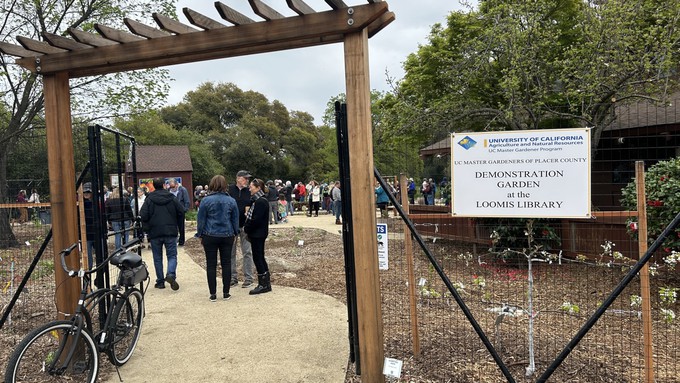
Placer County master gardeners welcome public to experience their growing resource, now in spring bloom

It was late March when the Demonstration Garden first opened at the Loomis Library. Guaranteed there will be more blooms, bigger plants and plenty of sunshine this Saturday for the Spring Open House. Kathy Morrison
On Saturday, June 1, Placer County master gardeners will host their first Spring Open House at their new Demonstration Garden at Loomis Library. Admission is free.
From 10 a.m. to 2 p.m., dozens of master gardeners will be on hand to show visitors what they’ve been working months to create – a total transformation. What was originally 11,000 square feet of unused turf is now a vibrant water-wise garden packed with California natives, pollinator-friendly flowers and edible plants.
“The garden provides an educational environment with areas devoted to pollinator-friendly garden, HOA-friendly garden, rain garden, compost demonstration area, California native woodlands, a lawn-alternative meadow, hedgerows, an edible garden, straw-bale alternative and an orchard,” explain the master gardeners. “The plants and fruit trees are all small but have labels, and the labels have QR codes so visitors can learn more about them.”
Opened earlier this year on the library grounds, the garden will be bursting with spring color, as well as activities for all ages and all levels of gardeners.
“There will be kids activities, information tables staffed with experts in various gardening topics, live music and more,” say the hosts. “Experts will be on hand to answer questions about tool care, irrigation – we will have an expert from Hunter Industries on hand – ‘Ask a Master Gardener’ and vermiculture. Master gardeners will be present to answer questions about the garden and the various beds. We will have experts on California native plants and pollinators as well.”
Loomis Library is located at 6050 Library Drive, Loomis.
For more on the Demonstration Garden: https://pcmg.ucanr.edu/Demonstration_Garden/.
Comments
0 comments have been posted.Sacramento Digs Gardening to your inbox.
Food in My Back Yard Series
April 1: Don't be fooled by these garden myths
March 25: Fertilizer tips: How to 'feed' your vegetables for healthy growth
March 18: Time to give vegetable seedlings some more space
March 11: Ways to win the fight against weeds
March 4: Potatoes from the garden
Feb. 25: Plant a fruit tree now -- for later
Feb. 18: How to squeeze more food into less space
Feb. 11: When to plant? Consider staggering your transplants
Feb. 4: Starting in seed starting
Sites We Like
Garden Checklist for week of March 30
Your garden doesn’t mind April showers. Get busy now to enjoy those future flowers.
* Get ready to swing into action in the vegetable garden. As nights warm up over 50 degrees, start setting out tomato, pepper and eggplant transplants.
* From seed, plant beans, beets, cantaloupes, carrots, corn, cucumbers, melons, pumpkins, radishes and squash. (Soak beet seeds overnight in water for better germination,)
* Plant onion sets.
* In the flower garden, plant seeds for asters, cosmos, celosia, marigolds, salvia, sunflowers and zinnias.
* Transplant petunias, zinnias, geraniums and other summer bloomers.
* Plant perennials and dahlia tubers for summer bloom.
* Transplant lettuce and cabbage seedlings.
* April is the last chance to plant citrus trees such as dwarf orange, lemon and kumquat. These trees also look good in landscaping and provide fresh fruit in winter.
* Smell orange blossoms? Feed citrus trees with a low dose of balanced fertilizer (such as 10-10-10) during bloom to help set fruit. Keep an eye out for ants.
* Apply slow-release fertilizer to the lawn.